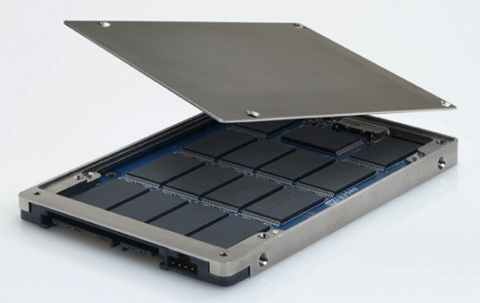solid state drive (SSD)
Whereas in the classic, magnetically operating hard disk drive( HDD), the data is stored on the magnetizable surface of the storage medium, solid state drives (SSD) operate with flash memories.
One advantage of solid state drives is that they have no mechanics and can therefore access the data much faster than classic hard disks, in which the read/write heads require about 5 ms to 10 ms to drive to the storage position of the data records. Theflash memories used in SSD drives are NAND flashArticleID="12444" ArticleURL="Flash- memory-flash-memory" ArticleTitle="Flash-memory">flash memories that require about 0.1 ms to 0.2 ms for this operation. Therefore, SSD drives can answer many thousands of requests in a second. In terms of data transfer rates, flash drives achieve speeds of 2.5 GB/s when reading, and 1.3 GB/s when writing data to the SSD memory.
Since solid state drives have no mechanics, they operate silently, are lighter and have lower power consumption. For example, 2.5" SSDs weigh about 50 grams, which is less than half the weight of hard drives. Their power consumption is around one watt (W).
Thanks to flash memory technology with Single Level Cells( SLC), Multi Level Cell( MLC), Triple Level Cell( TLC) and Quad Level Cell( QLC), SSD storage with several terabytes( TB) can be built in the smallest of spaces, with the advantage that no time is required for positioning the read/write heads. Access times are extremely short at 30,000 input/output operations per second. However, the flash memory technology limits the number of write and erase operations. It is determined by the Drive Writes Per Day( DWPD). The DWPD value tells how often the complete storage space of an SSD drive can be overwritten within 24 hours.
SSDs are available in the format of miniature hard disks with SATA interface and PCI Express in the M.2 form factor. Storage capacities can exceed 50 terabytes (TB) and data rates can be up to 600 MB/s for SATA 3 and 2.5 GB/s for PCIe 3.0 with four lanes.
Solid-state drives (SSD) are also used in combination with normal hard disk drives (HDD) and thus utilize the advantages of both technologies. The combined hybrid hard disk drives are called solid state hybrid drives( SSHD). Several SSD drives can be combined as solid state arrays( SSA) or all-flash arrays to form larger storage units.


.png)